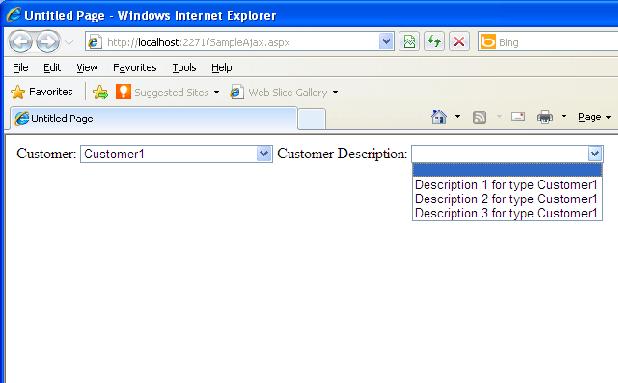Introduction
This article described how to use AJAX functionality using the popular JavaScript library (jQuery) with a minimal amount of code without using ASP.NET AJAX tool kit.
This example has two drop down controls whereas customer and customer description. Customer description will be loaded when customer drop down change without reloading the entire page.

Using the code

- Jquary library files need to be included to the project as shown above.
These are the library files
- jquery-1.4.1-vsdoc.js,jquery-1.4.1.js,
- query-1.4.1.min.js,
- jquery-1.5.2.min.js,
- jquery-ui-1.8.11.custom.min.js
Sample_ajax.js file will have Ajax implementation using the Jquary
var ajax = {
setDebugMode: function(){
this.debugMode = true;
},
get: function (requestUrl, data, loaderImageId, onSuccess, onComplete) {
if (loaderImageId) {
$("#" + loaderImageId).css('display', 'inline');
}
var completeFunction = function () {
if (onComplete) {
onComplete();
}
if (loaderImageId) {
$("#" + loaderImageId).css('display', 'none');
}
};
$.ajax({
type: "GET",
url: requestUrl,
data: data,
context: this,
success: function (response) {
onSuccess(response);
completeFunction();
},
error: function (response) {
alert("Ajax Request Failed");
this.showError(response);
completeFunction();
}
});
},
post: function (requestUrl, data, loaderImageId, onSuccess, onComplete) {
if (loaderImageId) {
$("#" + loaderImageId).css('display', 'inline');
}
var completeFunction = function () {
if (onComplete) {
onComplete();
}
if (loaderImageId) {
$("#" + loaderImageId).css('display', 'none');
}
};
$.ajax({
type: "POST",
url: requestUrl,
context: this,
data: data,
success: function (response) {
onSuccess(response);
completeFunction();
},
error: function (response) {
alert("Ajax Request Failed");
this.showError(response);
completeFunction();
}
});
},
showError: function(requestObject){
if (this.debugMode){
alert(requestObject.responseText);
}
}
};
ASPX Page(SampleAjax.aspx)
Include the java script as below
<script type="text/javascript" src='<%= this.ResolveUrl("~/Scripts/jquery-1.5.2.min.js")%>' ></script>
<script type="text/javascript" src='<%= this.ResolveUrl("~/Scripts/jquery-ui-1.8.11.custom.min.js")%>' ></script>
<script type="text/javascript" src='<%= this.ResolveUrl("~/Scripts/sample_ajax.js")%>' ></script>
Write Java script to call customer descriptions when customer drop down change
<script type="text/javascript">
<% if (SampleJSONWeb.ConfigurationData.DebugMode){ %>
ajax.setDebugMode();
<%} %>
$(document).ready(function ()
{
$("#<%= customerDropDown.ClientID %>").change(function ()
{
var customerTypeId = $('#<%= customerDropDown.ClientID %>').val();
ajax.get('<%= this.ResolveUrl("~/LoadCustomerDescriptions.ashx")%>',
{ 'customerTypeId': customerTypeId },
'CustomerDescriptionsLoader',
function (response)
{
$('#<%= customerDescriptionDropDown.ClientID %> option').remove();
for (var i = 0; i < response.Data.length; i++)
{
$('#<%= customerDescriptionDropDown.ClientID %>').append(getOptionString(response.Data[i]));
}
}
);
});
function getOptionString(dataElement)
{
return "<option value='"+dataElement.Id+"' >"+dataElement.Name+"</option>";
}
});
</script>
LoadCustomerDescriptions.ashx will be invoked by above java script.
public class LoadCustomerDescriptions : JsonRequestHandler
{
public override void ProcessRequest(HttpContext context)
{
string customerTypeId = context.Request.QueryString["customerTypeId"].ToString();
GetData getData = new GetData();
IList<ReferenceData> data = getData.GetCustomerescriptions(customerTypeId);
data.Insert(0, new ReferenceData(string.Empty, string.Empty));
Dictionary<string, string> response = new Dictionary<string, string>();
response.Add("Data", GetJsonCollection<ReferenceData>(data));
SetResponse(context, response);
}
}
The above method get the data from back end and send back as JSON format. JSON handler has the implementation to manage JSON data as below
using System;
using System.Collections.Generic;
using System.Web;
using System.Text;
using System.Reflection;
using System.Web.SessionState;
namespace SampleJSONWeb
{
public abstract class JsonRequestHandler : IHttpHandler, IRequiresSessionState
{
public abstract void ProcessRequest(HttpContext context);
protected void SetResponse(HttpContext context, string jsonResponse)
{
context.Response.Cache.SetExpires(DateTime.Now);
context.Response.ContentType = "application/json";
context.Response.Write(jsonResponse);
context.Response.End();
}
protected void SetResponse(HttpContext context, Dictionary<string, string> attributes)
{
SetResponse(context, GetJsonObject(attributes));
}
protected void SetResponse<T>(HttpContext context, T obj)
{
SetResponse(context, GetJsonObject<T>(obj));
}
protected T CreateObjectFromRequest<T>(HttpContext context) where T: new()
{
T ob = new T();
PropertyInfo[] properties = typeof(T).GetProperties();
foreach (PropertyInfo property in properties)
{
string value = context.Request.Params[property.Name];
if (value == null)
{
continue;
}
if (property.PropertyType != typeof(string) && value == string.Empty)
{
continue;
}
object convertedValue = Convert.ChangeType(value, property.PropertyType);
if (convertedValue == null)
{
continue;
}
property.SetValue(ob, convertedValue, null);
}
return ob;
}
protected string GetJsonObject(Dictionary<string, string> attributes)
{
StringBuilder jsonBuilder = new StringBuilder();
jsonBuilder.Append("{");
bool firstTime = true;
foreach (string key in attributes.Keys)
{
if (!firstTime)
{
jsonBuilder.Append(",");
}
string name = key;
object value = attributes[key];
jsonBuilder.Append("\"" + name + "\":" + value.ToString());
firstTime = false;
}
jsonBuilder.Append("}");
return jsonBuilder.ToString();
}
protected string GetJsonCollection<T>(IEnumerable<T> collection)
{
StringBuilder jsonBuilder = new StringBuilder();
jsonBuilder.Append("[");
bool first = true;
foreach (T item in collection)
{
if (!first)
{
jsonBuilder.Append(",");
}
jsonBuilder.Append(GetJsonObject<T>(item));
first = false;
}
jsonBuilder.Append("]");
return jsonBuilder.ToString();
}
protected string GetJsonObject<T>(T obj)
{
PropertyInfo[] properties = typeof(T).GetProperties();
StringBuilder jsonBuilder = new StringBuilder();
jsonBuilder.Append("{");
bool firstTime = true;
foreach (PropertyInfo property in properties)
{
if (!firstTime)
{
jsonBuilder.Append(",");
}
string name = property.Name;
object value = property.GetValue(obj, null);
jsonBuilder.Append("\"" + name + "\":\"" + value.ToString() + "\"");
firstTime = false;
}
jsonBuilder.Append("}");
return jsonBuilder.ToString();
}
public bool IsReusable
{
get
{
return false;
}
}
}
}
Pubudu Kasakara is working as Solution Architect in Singapore. He has more than 11 years of professional involvement in the IT industry. Worked in successful projects involving mainly the Service Oriented Application by contributing to all requirements gathering, design and implementation phases. He is having experience with SOA applications development, Microsoft .NET, BizTalk, He is member of Charted It professional in UK.
Solution Architect
http://www.kasakara.com
